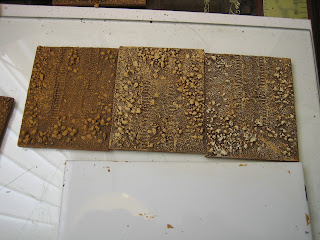 |
| Newly based, 115th Kradschutzen Battalion swans out into the desert. |
Before I start, as with Eskimos and snow, there a lots of different types of desert, and mine is a specific patch of it.
I am concentrating my efforts on Operation Crusader (November - December 1941), which was mostly fought in Libya on the top of the escarpment that follows the coast to the north. Because of the season (there was torrential rain and sleet during the offencive), and because of the proximity to the coast and the rain showers that proximity brings, my bases are quite well foliated. Perhaps they are a little over foliated, it depends on what photographs you look at. Over foliated, or not, one thing that all first hand accounts attest to is the monotonous colour with subtle variation in texture, especially at certain times of the day. It is the variation in texture that I go for.





When basing tracked vehicles I add a further step. Immediately after the second sanding I add a sprinkle of fine sand.....

Then press the tracks of the vehicle into the surface of the base. Then shake off the excess fine sand.
 This actually works!
This actually works!


 I do three highlights. The Sd251s that go on these three bases were stuck onto the base with super glue at this point.
I do three highlights. The Sd251s that go on these three bases were stuck onto the base with super glue at this point.
 Then, using artists acrylic, I paint the flora dark brown - and it comes out browny green
Then, using artists acrylic, I paint the flora dark brown - and it comes out browny green
then I dry brush it so that it blends in with the rest of the basing. Although not shown here, I sometimes add Woodland Scenics clumps - painted dark brown and drybrushed brown, or I add pale coloured static grass shop made 'tufts', or I just leave.
I think the bases have a subtle variation of texture and colour that makes them a little more interesting than the sanded bases you sometimes see.
5 comments:
Great tutorial. I like the idea of shading the foliage with ink. Something I had not thought to do.
It has the advantage of making it more 'rigid' for drybrushing and also flattens it down a bit.
very well done, congratulations on your tutorial
Thanks for this, I love a good "How to".
FMB
Great method. Thanks for posting.
Post a Comment